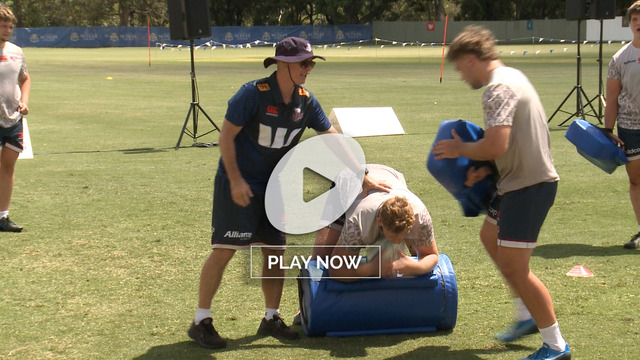Is the ‘jackal’ a protected species? – Southern Hemisphere (part two)
Round 9 of Super Rugby has just been completed, approximately halfway through the regular season. That seems as good a stage as any to judge whether a consensus point of balance has been reached in the refereeing of the new breakdown laws in the Southern Hemisphere.
Sadly, the answer to that question seems to be ‘No’, as it is currently in the game up North. No sooner had I written a recent article for The Rugby Site pointing out the paucity of ground turnovers in two matches from round four (Rebels-Brumbies and Hurricanes-Crusaders) – seven steals in 342 rucks – than I sat down to watch another Canes game against one of their New Zealand Conference rivals (the Chiefs) where the momentum of the officiating ran in the opposite direction!
In this game the takeaway ratio resembled the average under the old laws far more – a combined total of nine turnovers over 144 rucks yielding a 93.75% retention rate.
The match was refereed by Jamie Nutbrown, one of an emerging group of young officials (like Glen Jackson) with comparatively recent professional playing experience.
Officiating in the Super Rugby tournament historically tends to favour the attack rather than the defence. Nutbrown’s performance was atypical in the sense that – up until the last three minutes of the game – he had had awarded five penalties against the attacking side at the breakdown, and only two against the defending team. Only a couple of late pens against a Chiefs side who were two scores down and desperate to get the ball back, helped even up the tally. This was highly unusual.
Attacking offences centred on angle of entry and collapsing down over the ball, and a number of the decisions were far from clear-cut:
Here the Chiefs’ #10 Damian McKenzie actually doubles back in behind Solomona Alaimalo in order to enter ‘through the gate’ and clean out the Canes’ Vince Aso, but he is still penalized for side entry.
In the following instance, Hurricane second row Michael Fatialofa comes in low and hard to clean out Brodie Retallick and ‘reloads’ on to his hands immediately – but it does not prevent a whistle for flopping down over the tackled player from Nutbrown.
Nutbrown also gave the defender an unusual amount of licence to win the ball on the floor. Whenever there was a doubt concerning the legitimacy of a turnover attempt on the deck, he favoured the jackal. A number of scenarios echoed those supervised by Nigel Owens in the England-Scotland game:
This is a reprise of the Maro Itoje event from England-Scotland at 36:37. Two Hurricanes are cleaned out and away from the ball, but according to the referee a ruck has still not been formed:

The second cleanout in particular shows #20 Liam Messam on his feet and over the tackled player/ball, which represents the point at which ‘no hands can be used’ under the new laws. But Gareth Evans is allowed to reach over and pinch the ball nonetheless.
Jamie Nutbrown did not always enforce the defensive release of the ball in the tackle to allow placement, just like Nigel Owens in the 5th minute of England-Scotland.
The Hurricanes ball-carrier Brad Shields is never allowed to turn his shoulders in the direction of the placement once he hits the ground, and the ball is never visible before it emerges rather mysteriously on the Chiefs’ side:

Likewise, the refereeing of side entry was nothing like as strict on defence as it was on attack. Early in the game, the Chiefs’ Lachlan Boshier was allowed to jackal for the ball successfully from a position from which logic suggests it should have been impossible for him to compete:
The Hurricanes number 8 forward Gareth Evans has made a plunge up the middle on the pick & jam, and Boshier has had to run backwards towards the new tackle site:

In reality, Boshier has not circled all the way around and come back in ‘through the gate’ as required by law, he has slipped rather neatly in at the side in order to get his hands on the ball – which is why the Canes’ first cleanout player (Vaea Fifita) misses him.
Summary “If only…”. If only all jackal attempts were as easy to referee as Sam Cane’s classic takeaway just after half-time:
Cane gets his hands on the ball immediately as the law requires, lays it back to his half-back, mission accomplished. No ifs, no buts – turnover.
Unfortunately this is seldom the case. Take a look at the (more typical) plight of Canes’ #13 Ngani Laumape in the following example:
Laumape survives the cleanout (he’s still on his feet) but he cannot play at the ball with his hands a second time. He cannot kick it out either under the new law amendment:
Law 16.4
A player must not kick the ball out of a ruck. The player can only hook it in a backwards motion.
When he goes to hook it back with his foot, there is a body in the way on the ground, and if he plays at the opposing half-back approaching the tackle zone he is penalized!
The conundrum of the breakdown – maintaining the contest while making it easier to referee – has yet to be resolved by the well-meaning ‘simplicity’ of the new laws. Those laws are not simpler in practice, and if anything they are currently forcing referees (even the very best ones) to one extreme or the other. Either they officiate according to the letter and accept a game with far fewer breakdown turnovers, or they choose to maintain the contest by ignoring them. The ‘Gordian knot’ of the tackle area has yet to be untangled.
.png)












.jpg)
.jpg)





_no_button.jpg)

